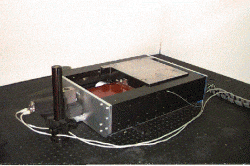PI(S):
Sponsor(s):
Wafer steppers are used in photolithography to position the uncut silicon wafer underneath a lens assembly in order to expose each of the future microchips. As such, the machine is required to have long travel, sub-micron resolution, and a settling time that is as fast as possible. The faster the machine settles, the more microchips can be produced. Typically, steppers are approached by stacking a short-travel, high resolution stage on top of a long-travel, low resolution design. This can lead to difficulties in achieving fast settling times. Our design uses magnetic bearings in combination with a six phase linear motor to combine the actions of the coarse and fine stages into a single moving element, thus allowing the long travel, high resolution, and fast settling times required.
Six Degree of Freedom MagLev Photolithography Stage
 Magnetic bearings are capable of applying force and torque to a suspended object without rigidly constraining any degrees of freedom. Additionally, the resolution of magnetic bearings is limited only by sensors and control, and not by the finish of a bearing surface. For these reasons, magnetic bearings appear to be ideal for precision wafer positioning in lithography systems. To demonstrate this capability a linear magnetic bearing has been constructed which uses variable reluctance actuators to control the motion of a 14.5 kg suspended platen in five degrees of freedom. A Lorentz type linear motor of our own design and construction is used to provide motion and position control in the sixth degree of freedom. The stage performance results verify that the positioning requirements of photolithography can be met with a system of this type.
Magnetic bearings are capable of applying force and torque to a suspended object without rigidly constraining any degrees of freedom. Additionally, the resolution of magnetic bearings is limited only by sensors and control, and not by the finish of a bearing surface. For these reasons, magnetic bearings appear to be ideal for precision wafer positioning in lithography systems. To demonstrate this capability a linear magnetic bearing has been constructed which uses variable reluctance actuators to control the motion of a 14.5 kg suspended platen in five degrees of freedom. A Lorentz type linear motor of our own design and construction is used to provide motion and position control in the sixth degree of freedom. The stage performance results verify that the positioning requirements of photolithography can be met with a system of this type.
